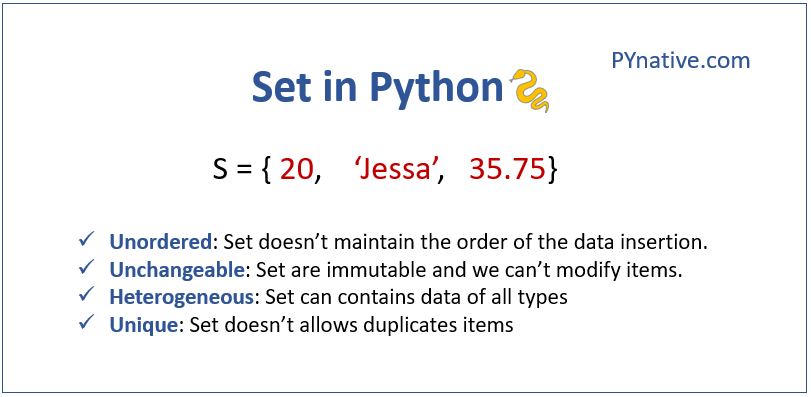Understanding Python Sets
Python sets are unordered collections of unique elements. They are defined by enclosing a comma-separated list of elements within curly braces {}. Sets are mutable, meaning you can add or remove elements after creation, but the elements themselves must be immutable (like numbers, strings, or tuples).
Creating Sets
To create a set, enclose elements within curly braces:
my_set = {1, 2, 3, "hello", True}
Note that an empty set is created using the set() function, not {} which creates an empty dictionary:
empty_set = set()
Set Characteristics
- Unordered: Elements have no specific order.
- Unique: Duplicate elements are automatically removed.
- Mutable: Elements can be added or removed.
- Iterable: You can iterate over elements using a
forloop. - Hashable: Sets can be used as keys in dictionaries.
Accessing Set Elements
Unlike lists or tuples, you cannot access elements in a set by index because they are unordered. However, you can iterate over them:
for item in my_set:
print(item)
Adding and Removing Elements
Add: Use the
add()method to add an element:Pythonmy_set.add(4)Remove: Use the
remove()method to remove a specific element. If the element is not present, it raises aKeyError:Pythonmy_set.remove("hello")Use the
discard()method to remove an element if it exists, without raising an error:Pythonmy_set.discard("world") # No error if "world" is not presentPop: Remove and return an arbitrary element:
Pythonremoved_item = my_set.pop()
Set Operations
Sets support various mathematical operations:
Union: Combine elements from two sets:
Pythonset1 = {1, 2, 3} set2 = {3, 4, 5} union_set = set1 | set2 # or set1.union(set2)Intersection: Find common elements between two sets:
Pythonintersection_set = set1 & set2 # or set1.intersection(set2)Difference: Find elements in set1 but not in set2:
Pythondifference_set = set1 - set2 # or set1.difference(set2)Symmetric Difference: Find elements in either set but not both:
Pythonsymmetric_difference_set = set1 ^ set2 # or set1.symmetric_difference(set2)
Set Membership
Use the in keyword to check if an element is in a set:
if 3 in my_set:
print("3 is in the set")
Set Methods
Python provides several built-in methods for set manipulation:
clear(): Removes all elements from the set.copy(): Returns a shallow copy of the set.isdisjoint(): Returns True if two sets have no common elements.issubset(): Returns True if all elements of one set are present in another.issuperset(): Returns True if all elements of another set are present in the set.update(): Adds elements from another set or iterable.
Set Comprehensions
Similar to list comprehensions, you can create sets using set comprehensions:
squares = {x**2 for x in range(5)}
Common Use Cases for Sets
- Removing duplicates from a list.
- Finding unique elements.
- Performing set operations like union, intersection, difference.
- Representing sets in mathematical problems.
- Implementing algorithms like graph traversal.
Advanced Set Topics
- Frozen sets: Immutable sets.
- Set theory operations: Explore complex set operations.
- Performance optimization: Understand set performance characteristics.
- Custom set classes: Create specialized set implementations.
By mastering sets, you’ll expand your Python toolkit and be able to solve a wide range of problems efficiently.
